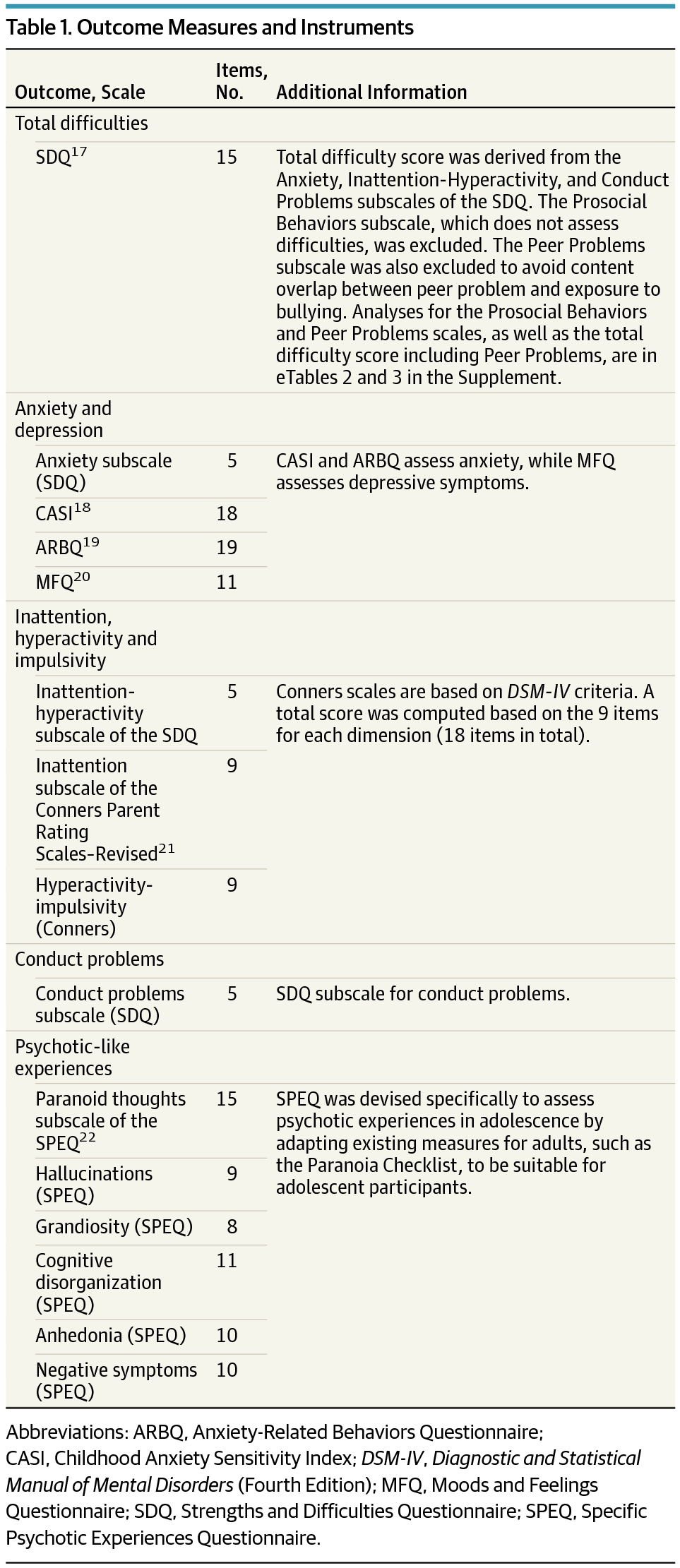JAMA Psychiatry ( IF 25.8 ) Pub Date : 2017-11-01 , DOI: 10.1001/jamapsychiatry.2017.2678 Timothy Singham 1 , Essi Viding 1 , Tabea Schoeler 1 , Louise Arseneault 2 , Angelica Ronald 3 , Charlotte M. Cecil 4 , Eamon McCrory 1 , Frülhing Rijsdijk 2 , Jean-Baptiste Pingault 1, 2

|
Importance Exposure to bullying is associated with poor mental health. However, the degree to which observed associations reflect direct detrimental contributions of exposure to bullying to mental health remains uncertain, as noncausal relationships may arise from genetic and environmental confounding (eg, preexisting vulnerabilities). Determining to what extent exposure to bullying contributes to mental health is an important concern, with implications for primary and secondary interventions.
Objective To characterize the concurrent and longitudinal contribution of exposure to bullying to mental health in childhood and adolescence using a twin differences design to strengthen causal inference.
Design, Setting, and Participants Participants were drawn from the Twins Early Development Study, a population-based cohort recruited from population records of births in England and Wales between January 1, 1994, and December 31, 1996. Data collection took place when the participants were between 11 and 16 years of age from December 1, 2005, to January 31, 2013. Data analysis was conducted from January 1, 2016, to June 20, 2017.
Exposures Participants completed the Multidimensional Peer-Victimization Scale at 11 and 14 years of age.
Main Outcomes and Measures Mental health assessments at 11 and 16 years of age included anxiety, depression, hyperactivity and impulsivity, inattention, conduct problems, and psychotic-like experiences (eg, paranoid thoughts or cognitive disorganization).
Results The 11 108 twins included in the final sample (5894 girls and 5214 boys) were a mean age of 11.3 years at the first assessment and 16.3 years at the last assessment. The most stringent twin differences estimates (monozygotic) were consistent with causal contribution of exposure to bullying at 11 years to concurrent anxiety, depression, hyperactivity and impulsivity, inattention, and conduct problems. Effects decreased over time; that is, substantial concurrent contributions to anxiety (β = 0.27; 95% CI, 0.22-0.33) persisted for 2 years (β = 0.12; 95% CI, 0.04-0.20) but not 5 years. Direct contributions to paranoid thoughts and cognitive disorganization persisted for 5 years.
Conclusions and Relevance This study is the largest to date to characterize the contribution of exposure to bullying in childhood to mental health using a twin differences design and multi-informant, multiscale data. Stringent evidence of the direct detrimental contribution of exposure to bullying in childhood to mental health is provided. Findings also suggest that childhood exposure to bullying may partly be viewed as a symptom of preexisting vulnerabilities. Finally, the dissipation of effects over time for many outcomes highlights the potential for resilience in children who were bullied. In addition to programs that aim to reduce exposure to bullying, interventions may benefit from addressing preexisting vulnerabilities and focus on resilience.
中文翻译:

童年时期欺凌行为的暴露和纵向贡献对心理健康的影响脆弱性和复原力的作用
重要性 受到欺凌会导致精神健康不良。但是,观察到的联想反映受到欺凌对心理健康的直接有害贡献的程度仍不确定,因为非因果关系可能源于遗传和环境混杂(例如,先前存在的脆弱性)。确定受到欺凌的程度在多大程度上有助于心理健康,这是一个重要的考虑因素,对主要和次要干预措施都有影响。
目的 使用双差异设计来加强因果关系推断儿童和青少年遭受欺凌对心理健康的同时和纵向贡献。
设计,设置和参与者 参与者来自Twins早期发展研究,该研究是从1994年1月1日至1996年12月31日期间在英格兰和威尔士出生的人口记录中招募的一个基于人口的队列。从2005年12月1日至2013年1月31日,年龄介于11至16岁之间。数据分析从2016年1月1日至2017年6月20日进行。
曝光 参与者完成了多维同行受害规模在11和14岁。
主要结果和措施 11岁和16岁时的心理健康评估包括焦虑,抑郁,多动和冲动,注意力不集中,行为问题以及类似精神病的经历(例如,偏执狂思想或认知障碍)。
结果 最终样本中包括11108名双胞胎(5894名女孩和5214名男孩),第一次评估时的平均年龄为11.3岁,而最后一次评估时的平均年龄为16.3岁。最严格的双胞胎差异估计(单卵)与11岁时遭受欺凌导致的并发焦虑,抑郁,多动和冲动,注意力不集中和行为问题的因果关系一致。效果随着时间的推移而降低;也就是说,对焦虑的大量并发贡献(β= 0.27; 95%CI,0.22-0.33)持续了2年(β = 0.12; 95%CI,0.04-0.20),但没有持续5年。对偏执思想和认知混乱的直接贡献持续了5年。
结论与相关性 这项研究是迄今为止最大的一项研究,使用双差异设计和多信息多尺度数据来表征儿童欺凌暴露对心理健康的贡献。提供了严格的证据,证明在儿童时期遭受欺凌对精神健康的直接有害影响。研究结果还表明,儿童时期遭受欺凌的部分原因可能是先前存在的脆弱性的症状。最后,随着时间的流逝,许多结局的影响消散凸显了被欺负儿童的复原力。除了旨在减少遭受欺凌行为的计划外,干预措施可能会受益于解决先前存在的漏洞并专注于抵御能力。



























 京公网安备 11010802027423号
京公网安备 11010802027423号